
The Philippine Sea is a marginal sea of the Western Pacific Ocean east of the Philippine Archipelago and the largest sea in the world, occupying an estimated surface area of 5 million square kilometers. The Philippine Sea Plate forms the floor of the sea. Its western border is the first island chain to the west, comprising the Ryukyu Islands in the northwest and Taiwan in the west. Its southwestern border comprises the Philippine islands of Luzon, Catanduanes, Samar, Leyte, and Mindanao. Its northern border comprises the Japanese islands of Honshu, Shikoku and Kyūshū. Its eastern border is the second island chain to the east, comprising the Bonin Islands and Iwo Jima in the northeast, the Mariana Islands in the due east, and Halmahera, Palau, Yap and Ulithi in the southeast. Its southern border is Indonesia's Morotai Island.

Toliara is a city in Madagascar.

The Malagasy are a group of Austronesian-speaking ethnic groups indigenous to the island country of Madagascar. Traditionally, the population have been divided into ethnic groups. Examples include "Highlander" groups such as the Merina and Betsileo of the central highlands around Antananarivo, Alaotra (Ambatondrazaka) and Fianarantsoa, and the "coastal dwellers" with tribes like the Sakalava, Bara, Vezo, Betsimisaraka, Mahafaly, etc. The Merina are also further divided into two subgroups. The “Merina A” are the Hova and Andriana, and have an average of 30–40% Bantu ancestry. The second subgroup is the “Merina B”, the Andevo, who have an average of 40–50% Bantu ancestry. They make up less than 1/3 of Merina society. The Malagasy population was 2,242,000 in the first census in 1900. Their population experienced a massive growth in the next hundred years, especially under French Madagascar.

Andavadoaka is a small fishing village located on the southwest coast of Madagascar. It is located in the Morombe (district), 45 km south of the town of Morombe in the region of Atsimo-Andrefana. It belongs to the rural municipality of Befandefa.
The Mikea are a group of Malagasy-speaking horticulturalists and foragers who are often described as the lowland hunter-gatherers of Madagascar. They inhabit the Mikea Forest, a patch of mixed spiny forest and dry deciduous forest along the coast of southwestern Madagascar. The Mikea are predominantly of Sakalava origin, although the term describes a lifestyle rather than an ethnic group per se, and individuals from a variety of Malagasy ethnic groups are found among the Mikea. The family encampments of the Mikea shift from prime corn planting territory at the edge of the forest in the rainy season to the interior forest rich with tenrecs and other game in the dry season, when the community becomes highly dependent on spongy tubers to meet their daily demand for water. Their lifestyle is interdependent with that of their neighboring Vezo fishermen and the Masikoro farmers and herders, with whom they trade products caught, foraged or cultivated in the forest. Many Mikea also occasionally engage in paid work such as guarding the zebu herds or tending the corn fields of others.

Betania is coastal village in Western Madagascar south of Morondava with a population of around 2400 Vezo fishermen. This village belongs to the municipality of Morondava and is situated on the southern side of the mouth of the Morondava River.
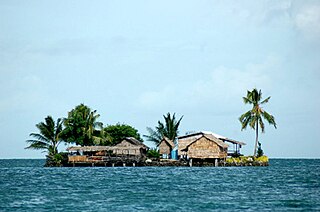
Lau Lagoon is a part of the Solomon Islands. It is located on the northeast coast of Malaita Island. The lagoon is more than 35 kilometers long and contains about 60 artificial islands built on the reef.
The following outline is provided as an overview of and topical guide to fishing:
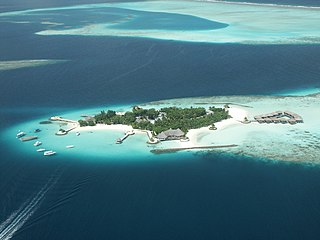
The fishing industry in the Maldives is the island's second main industry. According to national tradition in the words of former President Maumoon Abdul Gayoom, "Fishing is the lifeblood of our nation, it is inborn. From the soil on which we live, to the sea around us, it remains an integral part of our existence. Fishing, and our country and its people, [are] one and shall remain inseparable forever." The Maldives has an abundance of aquatic life and species of fish. Common are tuna, groupers, dolphin fish, barracuda, rainbow runner, trevally and squirrelfish and many more. Aside from being of essential importance to the economy, fishing is also a popular recreational activity in the Maldives, not only among locals but by tourists. The islands have numerous fishing resorts which cater for these activities.

Watamu Marine National Park and Reserve is located in Kenya. Established in 1968, it was one of Kenya's first marine parks. It is located about 90 miles (140 km) north of Mombasa, Kenya's second largest city. Its coral gardens are 300 metres (980 ft) from the shore and are home to approximately 600 species of fish, 110 species of stony coral and countless invertebrates, crustaceans and molluscs. Water temperature varies from 20 degrees Celsius to 30 degrees Celsius. The park was designated as a biosphere reserve in 1979.
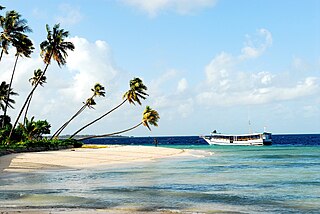
Wakatobi National Park is a marine national park in Southeast Sulawesi, Indonesia. The name of Wakatobi is a portmanteau of the four main Tukangbesi Islands: Wangi-wangi, Kaledupa, Tomia, and Binongko. Since 2005 the park is listed as a tentative World Heritage Site.
Velondriake, meaning “to live with the sea” in the Vezo dialect of the Malagasy language, is a locally managed marine area (LMMA). Established in 2006 in southwest Madagascar, Velondriake is home to over 7,000 resident Vezo people and covers a marine and coastal area of about 64,000 ha making it one of the largest LMMAs in the western Indian Ocean. The LMMA includes extensive coral reefs, mangroves, seagrass beds, baobab forests, spiny forest and other threatened habitats. The LMMA includes five permanent coral reef reserves, two permanent mangrove reserves, and numerous periodic fisheries closures (PFCs), primarily for octopus on reefs and for mud crab in mangroves.
The Tandroy are a traditionally nomadic ethnic group of Madagascar inhabiting the arid southern part of the island called Androy, tracing their origins back to the East Africa mainland. In the 17th century however, the Tandroy emerged as a confederation of two groups ruled by the Zafimanara dynasty until flooding caused the kingdom to disband around 1790. The difficult terrain and climate of Tandroy protected and isolated the population, sparing them from subjugation by the Kingdom of Imerina in the 19th century; later, the French colonial authority also struggled to exert its influence over this population. Since independence the Tandroy have suffered prejudice and economic marginalization, prompting widespread migration and intermarriage with other ethnic groups, and leading them to play a key role in protests that sparked the end of President Philibert Tsiranana's administration in 1972.
Blue Ventures is a registered charity focused on nurturing locally led marine conservation. The organisation partners with coastal communities that depend on marine resources.

The Barren Isles are an archipelago located in an area spanning 40 kilometres off the west coast of Madagascar, in the Melaky region. The archipelago consists of 9 main isles or sand banks.
Aquaculture in Madagascar started to take off in the 1980s. The industry includes the cultivation of sea cucumbers, seaweed, fish and shrimp and is being used to stimulate the country's economy, increase the wages of fishermen and women, and improve the regions ocean water quality. Coastal regions of Madagascar are reliant on the Indian Ocean's marine resources as a source of food, income, and cultural identity.

The Masikoro are a group of farmers and herders who inhabit areas surrounding the Mikea Forest, a patch of mixed spiny forest and dry deciduous forest along the coast of southwestern Madagascar in Toliara Province. Along with Vezo and Mikea, the Masikoro are Sakalava people, the difference being that Masikoro are of the land, Vezo are of the sea, and Mikea are of the forest.
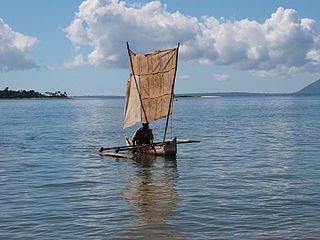
Lakana, also known as la'kana or laka, are traditional outrigger canoes of the Malagasy people of Madagascar. It is a single-outrigger canoe with a dugout main hull.
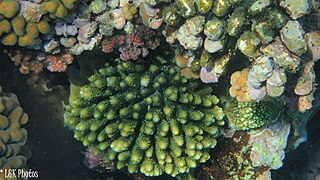
Nosy Ve-Androka National Park is a Protected Marine Area located in the southwestern part of Madagascar, south of Tulear, and 40 km south of the tourist village of Anakao. It lies between latitudes 25 ° 29/25 ° 09 South and longitudes 44 ° 50/45 ° 06 East and covers an area of 92080 ha. It is composed of Core Areas totalling 28,820 ha and Buffer Zones totalling 63,260 ha. The park is made up of eight parcels in two clusters, with part found along the coast adjacent to Tsimanampetsotsa National Park. It includes sections of the rich coral reef system of South West Madagascar in the Mozambique Channel, recognized as the third largest reef system in the world. Diversity of habitats include fringing reefs, barrier reefs, coral reef beds, seagrass area, open sea, rocky coast and sandy beaches. The Nosy Ve-Androka National Park contains about 140 species of coral and 240 species of fish. There are also rare species such as Coelacanths, marine turtle species, dugongs, dolphins and whales and sandy beaches that are used by nesting sea turtles.

The Tsiokantimo is a strong south wind that blows in the southwest region of Madagascar, usually from August to September. This wind hits the vast stretches of predominantly sandy coastline, causing wind erosion of the soil, and bringing a lot of dust to the city of Toliara in Madagascar, but also the anchovies that are pushed by the current and waves in the Tulear lagoon.



















